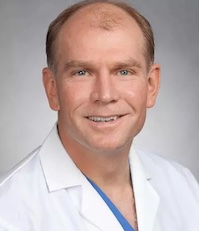Heart Failure Surgery
 Millions of people suffer from acute and chronic heart failure. In this interview, Dr. Gert Pretorius, Surgical Director of Heart Transplant and Mechanical Circulatory Support Program, discusses heart failure surgery innovations at UC San Diego, including expanding the donor pool by using the hearts of Hepatitis C-positive donors, thanks to highly effective Hepatitis C antivirals.
Millions of people suffer from acute and chronic heart failure. In this interview, Dr. Gert Pretorius, Surgical Director of Heart Transplant and Mechanical Circulatory Support Program, discusses heart failure surgery innovations at UC San Diego, including expanding the donor pool by using the hearts of Hepatitis C-positive donors, thanks to highly effective Hepatitis C antivirals.
February 20, 2018 | Interview by Lindsay Morgan
What is heart failure?
Heart failure is a condition where the heart is not capable of pumping sufficient blood through the vasculature to supply all of the organs with sufficient prefusion to perform their functions. It’s basically a failure of a pump that we are totally dependent on. We are faced with an epidemic of heart failure, and as the population ages, we will see a lot more of it.
How do you treat a failing heart?
There’s a whole spectrum, with surgery being something we do in the end stages. Heart failure treatments can include medication, diet treatments, exercise routines. If it progresses further the medication regime usually becomes more aggressive. Diuretics to manage fluid build-up is a mainstay; managing blood pressure is important. As heart failure progresses we start to get into a phase where we sometimes need a pacemaker and a defibrillator, and even biventricular pacing. Once these therapies are not effective anymore then we get to the end stage of heart failure and the option basically is to put the patient on hospice or to do rather dramatic surgeries where you replace the heart though a transplant or support some of the circulation by attaching a heart assist devices to the heart to take some and sometimes all of the circulation over.
How effective are end-stage surgeries?
The mechanical circulatory support technology is rapidly progressing to where we now see patients living many years—decades even—on ventricular assist devices (VADs). But ultimately heart transplant remains the most definitive way of treating advanced heart failure. The average patient receives an additional 12 years of life with a heart transplant.
There is a shortage of available organs for transplant in the United States, including for heart transplant. How does the United States compare to other countries?
The United States does a fairly good job with organ donation, but we are still far behind countries like Spain for instance. Spain has a policy where you are a donor unless you opt out. They don’t have to ask your permission for donation, you have to state, usually at the time of your drivers license renewal, that you do not want to be a donor. So that’s allowed Spain to have a great donation rate, almost double what the United States has.
What are some of the different strategies for expanding the donor pool?
We’ve looked at hearts that are more marginal, that traditionally would have been turned down. We’ve found that those hearts often can be recovered, and we’ve learned how to help our recipients who might be unstable in the early phases when we use a heart like that to stabilize. In the long term, we see good outcomes for those patients. We’ve expanded our donor pool through that mechanism.
We also have donors that traditionally would have been turned down because they have Hepatitis C. But in the last couple of years medications have become available that can actually cure Hepatitis C, which allows us to implant a Hepatitis C-positive heart into the recipient, knowing that we’re giving him Hepatitis C, but then to treat and heal him from Hepatitis C, and add another 12 years to his life because he has a functioning heart. We are the only program doing this on the West Coast.
What surgical contribution is your group making?
We are part of several ongoing medication and stem cell trials. We are also part of all the new VAD trials, which gives us access to newer devices and contributes to the knowledge and discovery of how to use these devices.
We’ve done a couple unique things in the assist device category: we realized that if we have a left VAD (LVAD) why not use that in a patient who has left-side and right-side heart failure, and put one on the right side. So, we are using VADS as a biventricular assist device. We published the biggest series in North America of biventricular assist device cases ( Annals of Surgery) and demonstrated that there are significant benefits of implanting a left ventricular assist device (LVAD) in the right atrium.
You grew up in South Africa and were a general practitioner there before moving to Canada and pursuing a residency in cardiac surgery, and, eventually, a fellowship at UC San Diego in Pulmonary Thromboendarterectomy (PTE). Why did you decide to pursue a career in heart surgery?
During my time as a GP, I always knew I had an affinity for doing surgery. Heart surgery encompasses physiology, anatomy and artistry, and it captures the imagination because everybody understands that without a functioning heart you’re dead. It is in some sense black and white, so it comes with a certain amount of adrenaline rush because whatever you do has vast implications for the patient. Life is beautiful, and the cardiac physiology is amazing. I can remember when I first saw an open chest, the heart beating, and the surgeon manipulating it, handling it and even cutting and sewing into it. It was pretty amazing.
